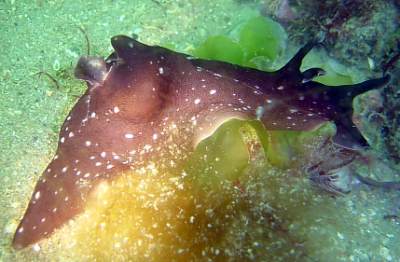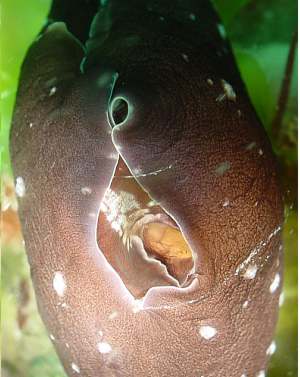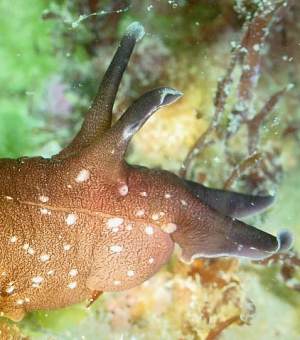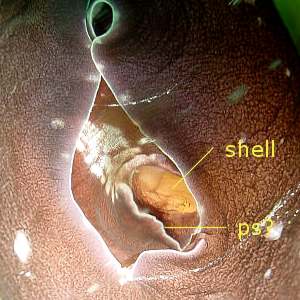Aplysia punctata (adult) from French Brittany
April 29, 2003
From: Marina Poddubetskaia

Dear Bill,
I spent last week-end diving near the famous Mont Saint-Michel and I found there some nice guys. For example, this large Aplysia. It looks a little like Aplysia punctata, but it seems to me quite different from the usual colour form. What do you think about it?
I include a close-up of the foramen [lower left]. I think the yellowish thing we can see here is the internal shell of this animal, isn’t it ?
Saint-Malo, France, Atlantic coast. Site: Bizeux., Depth: 4,5m., Size: 14-15cm., Temp: 12°C. April 19, 2003. Photos: Marina Poddubetskaia - Nembro website
Best wishes,
Marina.
nembro@nembro.info



Dear Marina,
I would say this is an adult Aplysia punctata. Compare this with the animal in your other message, which is a juvenile. This is the only species from that part of the world, with this colour pattern, in which the parapodia are joined posteriorly and the mantle foramen is large. For those of you not familiar with the term foramen, it is from the Latin word for a window and refers to the hole in the mantle through which the shell can be seen. In some species such as A. punctata and A. parvula it is large and the shell is easily seen, while in many it is an almost invisible pore, often on a short papillae. In the labelled close-up alongside you can also see a flap of mantle tissue which forms a siphon or spout directing water out of the mantle cavity.
Concerning the difference in shape and colour between these animals and those in your other message, the others are juveniles which are often red or reddish in colour. However the joined parapodia and large foramen are clearly visible
Best wishes,
Bill Rudman
Related messages
-
Re: Aplysia punctata mating, spawning and variations
From: Joao Pedro Tojal Loia Soares Silva, October 3, 2007 -
Aplysia punctata from the Western Isles, Scotland
From: Lindsay Bradley, October 3, 2007 -
Aplysia punctata mating, spawning and variations
From: Joao Pedro Silva, August 20, 2007 -
Aplysia punctata mating
From: Jim Anderson, August 20, 2007 -
Re: Appetitive behaviour in Aplysia
From: Mark Henry, August 22, 2006 -
Appetitive behaviour in Aplysia
From: Mark Henry, August 21, 2006 -
Markings on Aplysia punctata
From: Mark Henry, August 17, 2006 -
A summer spawn of Aplysia punctata
From: Mark.Henry, August 15, 2006 -
Sea Hare from Lochiver, Northwest Scotland
From: Colin Robertson, March 28, 2006 -
Spanish Sea Hares
From: Sascha Schulz, February 20, 2006 -
Sea Hare from Spain
From: Raul Castro, December 17, 2005 -
Aplysia punctata from Scotland
From: Cherry Welsh, August 19, 2005 -
Juvenile Aplysia from Norway
From: Kåre Telnes, July 30, 2005 -
Aplysia punctata from Croatia
From: Andrej Jaklin, March 4, 2005 -
Aplysia from Croatia
From: Andrej Jaklin, March 4, 2005 -
Age determination of Aplysia punctata
From: Marta K. Soffker, February 18, 2005 -
Aplysia punctata mating
From: Jim Anderson, November 27, 2003 -
Aplysia punctata from French Mediterranean
From: Marina Poddubetskaia, July 19, 2003 -
Aplysia punctata (juvenile) from French Brittany
From: Marina Poddubetskaia, April 29, 2003 -
Aplysia punctata in aquarium
From: Michael, November 10, 2002 -
Re: commensal bivalve & Aplysia
From: Dr.Stephen R Hoskins, June 18, 2002 -
Re: Commensal bivalve - Sea Hare
From: Dr. Stephen R. Hoskins, June 17, 2002 -
Re: galeommatoidean commensal on Aplysia?
From: Serge Gofas , June 13, 2002 -
Aplysia punctata and commensal? bivalve.
From: Stephen Hoskins, June 8, 2002 -
Aplysia punctata in Germany
From: Peter Gleisenstein , May 31, 2002 -
Aplysia punctata & 'passengers'
From: Dr. Stephen Hoskins, May 16, 2002 -
Aplysia punctata from Portugal
From: João Tojal Silva, April 23, 2002 -
Aplysia punctata defensive mechanism
From: Marilyn Jackson, December 13, 2000 -
What does Aplysia punctata eat?
From: Trevor Shand, August 7, 2000 -
Observations on Aplysia punctata
From: Andy Horton, October 2, 1999
